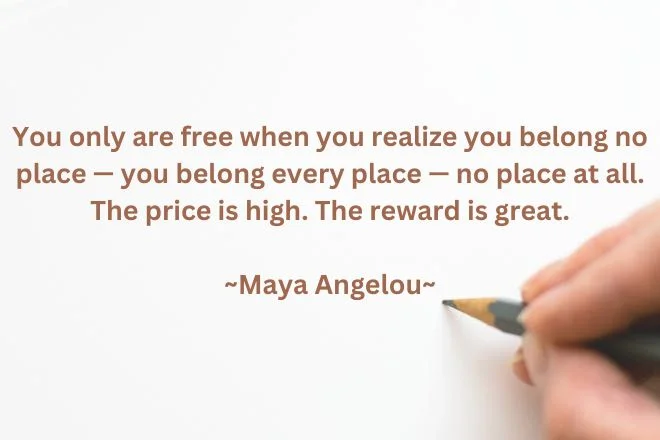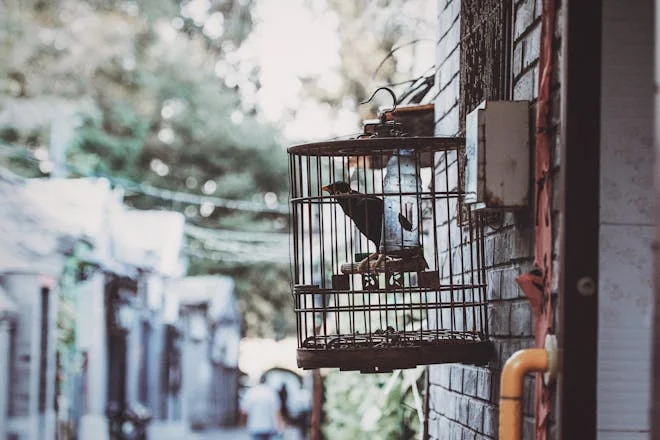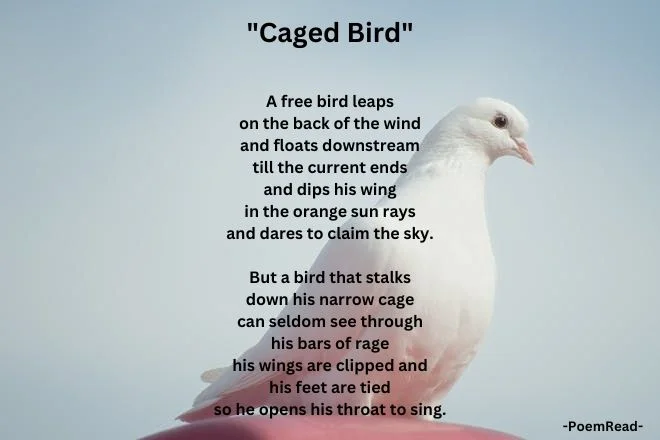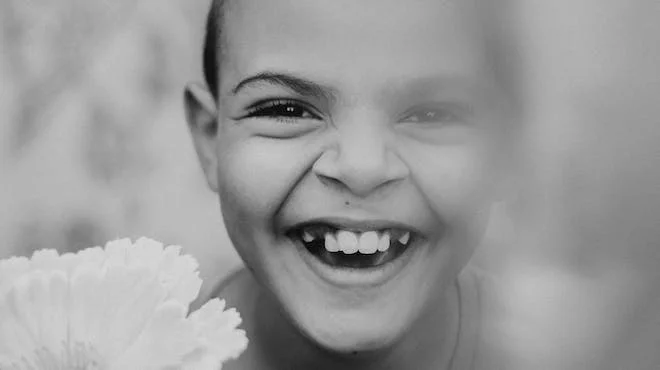
The poem “Caged Bird” by Maya Angelou is a powerful piece of literature that explores themes of freedom, oppression, and the human spirit. In this blog article, we examine various aspects of the poem, including its subject, the author’s background, the context in which it was written, the theme and tone, and the form and structure. Through a line-by-line analysis, we will uncover the poetic and literary devices used by Angelou and discuss the implications and meanings of the poem. So, let’s embark on this literary journey and unravel the beauty and depth of “Caged Bird.”
Caged Bird
A free bird leaps
on the back of the wind
and floats downstream
till the current ends
and dips his wing
in the orange sun rays
and dares to claim the sky.
But a bird that stalks
down his narrow cage
can seldom see through
his bars of rage
his wings are clipped and
his feet are tied
so he opens his throat to sing.
The caged bird sings
with a fearful trill
of things unknown
but longed for still
and his tune is heard
on the distant hill
for the caged bird
sings of freedom.
The free bird thinks of another breeze
and the trade winds soft through the sighing trees
and the fat worms waiting on a dawn bright lawn
and he names the sky his own.
But a caged bird stands on the grave of dreams
his shadow shouts on a nightmare scream
his wings are clipped and his feet are tied
so he opens his throat to sing.
The caged bird sings
with a fearful trill
of things unknown
but longed for still
and his tune is heard
on the distant hill
for the caged bird
sings of freedom.
Content
- About the Author : Maya Angelou
- Subject of "Caged Bird"
- Context of "Caged Bird"
- Theme and Tone of "Caged Bird"
- Narrator, Persona and setting of "Caged Bird"
- Form and Structure of "Caged Bird"
- Line-by-Line Analysis of "Caged Bird"
- Poetic and Literary Devices Used in "Caged Bird"
- FAQ
- Interactive Summary of "Caged Bird"
About the Author : Maya Angelou
Maya Angelou, born Marguerite Annie Johnson, was an American poet, memoirist, and civil rights activist. She was born on April 4, 1928, in St. Louis, Missouri, and faced numerous challenges throughout her life.
Angelou’s works often reflected her personal experiences as well as the struggles and triumphs of the African American community. Her writing style was emotive, expressive, and engaging, making her a beloved figure in the world of literature.
Subject of “Caged Bird”
The subject of “Caged Bird” revolves around the contrast between freedom and captivity, symbolized through the contrasting lives of a free bird and a caged bird. The poem delves into the emotional and psychological impact of oppression, confinement, and the longing for autonomy and self-expression.
The caged bird represents individuals or communities facing systemic barriers, discrimination, and limited opportunities. Its physical confinement in a narrow cage symbolizes the constraints imposed by societal norms, prejudice, and institutionalized oppression. Despite these challenges, the caged bird’s song becomes a powerful expression of resilience, defiance, and the human spirit’s enduring quest for freedom.
In contrast, the free bird embodies autonomy, privilege, and unrestricted movement. It represents the ideal of liberation, free from restrictions or limitations imposed by society. On the other hand, these are the benefits reaped by the privileged communities. Furthermore, the free bird’s carefree existence serves as a stark contrast to the caged bird’s plight, highlighting the disparities and injustices inherent in society.
Through rich imagery, vivid language, and evocative symbolism, “Caged Bird” delves into themes of identity, inequality, resilience, and the human capacity to find beauty and meaning even in the most challenging circumstances. It invites readers to empathize with the struggles of the marginalized while celebrating the strength and resilience of the human spirit.
Context of “Caged Bird”
Maya Angelou’s “Caged Bird” was written during a tumultuous period in American history, particularly during the civil rights movement of the 1960s. This context is crucial to understanding the poem’s thematic underpinnings and emotional depth. Angelou herself was a prominent figure in the civil rights movement, using her voice and literary prowess to advocate for equality, justice, and empowerment.
The poem’s context of racial segregation, discrimination, and systemic oppression resonates throughout its lines. The imagery of the caged bird trapped in confinement parallels the experiences of marginalized communities, particularly African Americans, who were often denied basic rights and freedoms. The juxtaposition of the caged bird with the free bird symbolizes the stark contrast between privilege and oppression, autonomy and restriction.
“Caged Bird” is a reflection on human resilience and the timeless quest for freedom and dignity. It speaks to universal truths about our desire for autonomy and self-expression amid social and political challenges. It also serves as a timeless commentary on themes like oppression, liberation, and the human spirit’s ability to overcome adversity.
Theme and Tone of “Caged Bird”

The Resonant Theme of “Caged Bird”
Maya Angelou’s “Caged Bird” deeply explores the theme of freedom and captivity through a powerful metaphor involving two birds: one soaring freely in the sky and the other confined to a cage. This stark comparison sheds light on the contrasting experiences of liberty and oppression.
At its core, the poem serves as an allegory for the African American experience, especially during the Civil Rights era. It portrays the intense yearning for freedom and the harsh realities of racial segregation and discrimination. Furthermore, the contrast between the free bird claiming the sky and the caged bird’s limited mobility symbolizes the systemic barriers that hinder certain groups from reaching their full potential.
Angelou’s theme extends beyond the historical context, touching on universal human experiences. The caged bird’s song, filled with fear yet brimming with hope, resonates as a symbol of the enduring human spirit. It sings not only for itself but for all who yearn for freedom, making its voice heard far and wide.
In essence, “Caged Bird” is a call to recognize and challenge the societal cages that restrict individuals and to celebrate the enduring song of freedom that lives within each of us. It’s a reminder that the struggle for liberation is ongoing and that the desire for freedom is a natural and universal right.
Through “Caged Bird,” Maya Angelou gives voice to the voiceless and strength to the weary, inspiring generations to continue the fight for equality and justice. The theme of the poem remains relevant today, urging us to listen to the caged bird’s song. It encourages us to work towards a world where every “bird,” regardless of their circumstances, can spread their wings and soar.
Tone of “Caged Bird”
The tone of the poem is a delicate balance between melancholy and hope. Angelou masterfully conveys the caged bird’s sorrow and longing through the “fearful trill” of its song, yet there is an underlying current of resilience and optimism. The repetitive nature of the caged bird’s song throughout the poem emphasizes a persistent hope that transcends the bird’s physical confinement.
The contrast between the free bird’s carefree life and the caged bird’s constrained existence creates a tone that is both reflective and critical. Angelou invites the reader to ponder the injustices of the world while also admiring the caged bird’s enduring spirit.
Narrator, Persona and setting of “Caged Bird”
In Maya Angelou’s “Caged Bird,” the speaker is an omniscient narrator who presents the experiences of two birds—one free and one caged—to explore themes of freedom and oppression. The speaker’s voice is empathetic and reflective, conveying the emotions and struggles of the caged bird while contrasting them with the free bird’s untroubled life.
The persona of the poem can be interpreted as the collective voice of those who have been oppressed, particularly the African American community. The caged bird’s longing for freedom and its song of hope reflect the historical and personal struggles of Angelou and others who have faced racial discrimination and injustice.
The setting of “Caged Bird” is both literal and metaphorical. Literally, it contrasts the natural, open environment of the free bird with the confined space of the caged bird. Metaphorically, the setting extends to the broader social context, reflecting the societal constraints imposed on marginalized groups and their enduring spirit of resilience.
Form and Structure of “Caged Bird”
The form and structure of Maya Angelou’s “Caged Bird” contribute significantly to the poem’s impact, emotive resonance, and thematic exploration. Let’s delve into the key aspects of its form and structure:
Stanzas and Line Length
- “Caged Bird” is structured into six stanzas, each with varying line lengths. This variation in line length creates a dynamic rhythm and pacing, enhancing the poem’s emotional depth and narrative flow.
- The first stanza consists of shorter lines, reflecting the freedom and fluidity of the free bird’s movements and experiences.
- In contrast, stanzas depicting the caged bird’s confinement often have longer lines, conveying a sense of restraint and limitation.
Pauses and Line Breaks
- Angelou strategically uses pauses and line breaks to create emphasis, build tension, and guide the reader’s attention. These pauses allow for moments of reflection and contemplation within the poem.
- For instance, the use of enjambment, where a sentence or phrase continues onto the next line without punctuation, creates a sense of fluidity and uninterrupted flow. This technique is particularly effective in highlighting the contrast between freedom and captivity.
Punctuation
- The poem’s punctuation is sparse, with minimal use of commas and periods. This lack of punctuation contributes to the poem’s free verse structure, allowing for a more natural and rhythmic reading experience.
- However, when punctuation is used, such as in the phrase “nightmare scream,” it serves to create emphasis and add emotional impact to specific moments in the poem.
Rhyme and Meter
- “Caged Bird” is written in free verse, lacking a strict rhyme scheme or meter. This free-form structure mirrors the thematic exploration of freedom and captivity, allowing for fluidity and emotional resonance.
- While the poem does not adhere to a consistent rhyme scheme, there are instances of internal rhyme and assonance that add musicality and texture to the language.
Repetition and Refrain
- The refrain “the caged bird sings” is repeated throughout the poem, serving as a powerful refrain that reinforces the central theme and adds a rhythmic cadence to the poem.
- This repetition creates a sense of unity and continuity, highlighting the persistent expression of longing, resilience, and defiance against oppression.
Overall, the form and structure of “Caged Bird” are integral to its thematic exploration and emotional impact. Through varying line lengths, pauses, punctuation choices, and rhythmic patterns, Maya Angelou crafts a poem that resonates with universal truths about freedom, resilience, and the enduring human spirit’s quest for autonomy and self-expression.
Line-by-Line Analysis of “Caged Bird”

First Stanza
The poem begins by contrasting the freedom of a bird that can soar with the wind and claim the sky with the restricted life of a caged bird. The free bird can “leap on the back of the wind” and “claim the sky,” signifying the ability to pursue dreams and aspirations without hindrance, a stark contrast to the constrained life of the caged bird. This represents the aspirations and dreams of black Americans, who desire the same freedom and opportunities as their white counterparts.
“A free bird leaps / on the back of the wind”
These opening lines set the tone for the poem, introducing us to the imagery of a free bird in flight. The word “leaps” suggests a sense of joy and boundless energy, emphasizing the bird’s uninhibited movement. The phrase “on the back of the wind” evokes a sense of freedom and adventure, as the bird harnesses the power of nature to soar effortlessly.
“and floats downstream”
Here, the imagery shifts to a serene and effortless gliding motion as the bird “floats downstream.” This image conveys a sense of tranquility and natural harmony, highlighting the bird’s seamless integration with its environment.
“till the current ends”
The phrase “till the current ends” suggests the bird’s journey along a natural course, following the flow of the wind. It implies a sense of continuity and inevitability as the bird navigates its path until reaching a natural conclusion.
“and dips his wing / in the orange sun rays”
This image of the bird dipping its wing into the “orange sun rays” adds a visual element of warmth and radiance. The color orange symbolizes energy, vitality, and passion, further enhancing the imagery of freedom and joy.
“and dares to claim the sky”
The phrase “dares to claim the sky” carries a sense of boldness and assertion. It portrays the bird’s fearless attitude as it asserts its right to inhabit and traverse the expansive sky, reinforcing the theme of freedom and autonomy.
Overall, the first stanza of “Caged Bird” paints a picture of freedom, using evocative imagery and sensory details to capture the essence of unrestrained movement, natural beauty, and the boundless possibilities of the open sky.
Second Stanza
This stanza introduces the caged bird, trapped within its narrow confines. The imagery of “bars of rage” suggests the pent-up anger and frustration resulting from oppression and confinement. The caged bird’s “wings are clipped” and “feet are tied,” symbolizing the limitations imposed by systemic barriers, reminiscent of the limitations faced by Black Americans due to racial discrimination.
“But a bird that stalks / down his narrow cage”
The stanza begins with a stark contrast to the freedom depicted in the first stanza. The word “stalks” suggests a cautious movement, highlighting the confined and constrained nature of the caged bird’s existence. The phrase “narrow cage” reinforces the sense of confinement, emphasizing the bird’s limited space and lack of freedom.
“can seldom see through / his bars of rage”
Here, the imagery shifts to the emotional state of the caged bird. The phrase “bars of rage” symbolizes the bird’s frustration, anger, and sense of imprisonment. It conveys the psychological effects of confinement, where physical barriers stifle the bird’s emotions.
“his wings are clipped and / his feet are tied”
These lines emphasize the physical limitations imposed on the caged bird. The imagery of “clipped wings” and “tied feet” symbolizes the bird’s inability to fly or move freely, further reinforcing its captivity and helplessness.
“so he opens his throat to sing”
Despite its confinement and despair, the caged bird finds solace and expression through song. The act of “opening his throat to sing” symbolizes the bird’s resilience and defiance against oppression. It reflects the human capacity to find beauty and meaning even in the most challenging circumstances.
The second stanza of “Caged Bird” portrays the stark contrast between freedom and captivity, highlighting the emotional and physical toll of confinement on the caged bird. Through vivid imagery and emotive language, Maya Angelou taps into themes of oppression, resilience, and the enduring power of expression.
Third Stanza
Here, the caged bird’s song is described as “fearful” yet longing for freedom. This reflects the emotional burden experienced by those who are denied basic rights and opportunities based on race. The caged bird’s song carries a message of yearning for liberation and equality.
“The caged bird sings”
This opening line echoes the refrain from the previous stanza, emphasizing the central theme of the poem—the caged bird’s song as a symbol of resilience and longing for freedom.
“with a fearful trill”
The phrase “fearful trill” conveys the mixed emotions of the caged bird. While it sings with fear, there’s also a sense of courage and determination in its song, reflecting the bird’s defiance against its circumstances.
“of things unknown”
This line suggests that the caged bird’s song is not just about its immediate environment but also encompasses a longing for the unknown, for possibilities beyond its confinement. It adds depth to the bird’s yearning for freedom and exploration.
“but longed for still”
Here, Angelou emphasizes the persistent desire of the caged bird for freedom. Despite the challenges and limitations, the bird continues to yearn for what it does not have, highlighting the innate human drive for liberty.
“and his tune is heard / on the distant hill”
This imagery of the bird’s song reaching a distant hill symbolizes the universal nature of its longing and expression. Even though confined, the bird’s voice transcends boundaries, resonating with others who share similar aspirations for freedom.
“for the caged bird / sings of freedom”
The stanza concludes with a reaffirmation of the caged bird’s song as a declaration of freedom. Through its music, the bird asserts its innate right to liberty and self-expression, despite its physical confinement.
In this stanza, Maya Angelou continues to explore the themes of resilience, longing, and the human spirit’s quest for freedom. The caged bird’s song becomes a powerful metaphor for the will to overcome adversity and assert one’s inherent dignity and autonomy.
Fourth Stanza
The contrast between the free bird’s carefree thoughts of pleasant experiences and the caged bird’s harsh reality emphasizes the disparity in lived experiences based on freedom or lack thereof. The “grave of dreams” symbolizes the loss of opportunities and shattered aspirations faced by marginalized communities.
“The free bird thinks of another breeze”
Here, Angelou shifts back to describing the free bird, contrasting its thoughts with the caged bird’s song. The phrase “thinks of another breeze” suggests the free bird’s carefree and spontaneous nature, always seeking new experiences and sensations.
“and the trade winds soft through the sighing trees”
This imagery of “trade winds soft through the sighing trees” evokes a sense of tranquility and natural beauty. It portrays the free bird’s environment as idyllic and harmonious, filled with gentle winds and whispering trees.
“and the fat worms waiting on a dawn bright lawn”
The image of “fat worms waiting” on a “dawn bright lawn” symbolizes abundance and opportunity. It reflects the free bird’s easy access to nourishment and the simple pleasures of nature, contrasting sharply with the caged bird’s limited resources.
“and he names the sky his own”
This line encapsulates the free bird’s sense of ownership and belonging in the vast expanse of the sky. It reinforces the theme of freedom and autonomy, as the bird claims its rightful place in the world without constraints.
The fourth stanza highlights the contrasting experiences of the free bird and the caged bird, emphasizing themes of abundance, autonomy, and natural beauty. Through vivid imagery and descriptive language, Maya Angelou creates a contrast between freedom and captivity, inviting readers to contemplate the complexities of human existence.
Fifth Stanza
Continuing the theme of resilience, the caged bird’s persistent singing despite captivity reflects the determination of oppressed individuals to resist and strive for freedom. The “distant hill” represents an unreachable goal or aspiration, symbolizing the ongoing struggle for justice and equality.
“But a caged bird stands on the grave of dreams”
The stanza opens with a powerful metaphor, depicting the caged bird’s confinement as a burial of its dreams. The image of standing “on the grave of dreams” conveys the profound loss and hopelessness experienced by the bird.
“his shadow shouts on a nightmare scream”
Here, Angelou uses vivid imagery to convey the caged bird’s anguish and despair. The metaphorical “shadow” of the bird represents its hidden pain and suffering, while the “nightmare scream” symbolizes the torment and captivity that haunt its existence.
“his wings are clipped and his feet are tied”
These lines reiterate the physical limitations imposed upon the caged bird, emphasizing its inability to escape or fulfill its natural instincts and desires.
“so he opens his throat to sing”
Similar to earlier stanzas, this line portrays the bird’s act of singing as a form of defiance and resilience. Despite its dire circumstances, the caged bird finds solace and expression through its song.
The fifth stanza delves deeper into the emotional and psychological toll of captivity, using evocative imagery and metaphors to depict the caged bird’s inner turmoil and longing for freedom. Maya Angelou continues to explore themes of oppression, resilience, and the human spirit’s enduring quest for autonomy and self-expression.
Final Stanza
The repetition of the final stanza reinforces the caged bird’s unwavering song, echoing the enduring spirit and resilience of marginalized communities. The “distant hill” remains a symbol of hope and perseverance, highlighting the ongoing quest for freedom and dignity.
“The caged bird sings”
The stanza begins with a repetition of the refrain, emphasizing the central theme of the poem – the caged bird’s song as a symbol of resilience, longing, and defiance against oppression.
“with a fearful trill”
This phrase echoes the earlier description of the caged bird’s song as having a “fearful trill,” highlighting the bird’s complex emotions of fear, longing, and courage.
“of things unknown”
Once again, Angelou underscores the caged bird’s yearning for the unknown, for experiences beyond its confinement. This line adds depth to the bird’s longing, suggesting a desire for exploration and discovery.
“but longed for still”
This repetition of “but longed for still” from a previous stanza reaffirms the persistent desire of the caged bird for freedom and fulfillment, despite its limitations and struggles.
“and his tune is heard / on the distant hill”
The imagery of the bird’s song reaching a “distant hill” symbolizes the universal nature of its expression and longing. Even though confined, the bird’s voice transcends boundaries, resonating with others who share similar aspirations for freedom.
“for the caged bird / sings of freedom”
The stanza concludes with a powerful affirmation of the caged bird’s indomitable spirit. Through its song, the bird asserts its right to freedom and self-expression, leaving a lasting impact on those who hear its voice.
In the final stanza of “Caged Bird,” Maya Angelou encapsulates the poem’s themes of resilience, longing, and the human spirit’s quest for freedom. The caged bird’s song becomes a symbol of hope and defiance, inspiring empathy and introspection in readers as they reflect on the complexities of oppression and the enduring power of expression.
Poetic and Literary Devices Used in “Caged Bird”

Metaphor
The central metaphor of the caged bird and the free bird serves as a powerful symbol of freedom and captivity. The caged bird represents oppressed individuals or marginalized communities, while the free bird symbolizes autonomy and liberation.
Imagery
Angelou employs vivid imagery throughout the poem to evoke sensory experiences and create a visual landscape for readers. Examples include “the back of the wind,” “orange sun rays,” and “nightmare scream,” which engage the reader’s imagination and emotions.
Symbolism
Various elements in the poem carry symbolic significance. The cage symbolizes confinement and restriction, while the sky represents freedom and limitless possibilities. These symbols deepen the poem’s thematic exploration and add layers of meaning.
Repetition
The refrain “the caged bird sings” is repeated throughout the poem, emphasizing the bird’s persistent expression of longing and resilience. This repetition creates a rhythmic cadence and reinforces the central theme.
Personification
The birds in the poem are personified, imbuing them with human-like emotions and actions. For instance, the caged bird “opens his throat to sing,” showcasing a human capacity for expression and defiance.
Alliteration
Angelou uses alliteration, or the repetition of consonant sounds, to add musicality and emphasis to certain phrases. An example is “fat worms waiting,” which creates a sense of abundance and natural imagery.
Enjambment
The use of enjambment, where a sentence or phrase continues onto the next line without punctuation, creates a fluid and uninterrupted flow in the poem. This technique enhances the poem’s emotional impact and narrative momentum.
Contrast
The contrast between the experiences of the free bird and the caged bird serves as a literary device to highlight themes of freedom, oppression, and resilience. This juxtaposition amplifies the poem’s thematic depth and complexity.
Irony
There’s an underlying irony in the poem’s title and refrain, “Caged Bird,” juxtaposed with the bird’s persistent singing. This irony underscores the paradoxical nature of captivity and the human spirit’s ability to find solace and expression even in confinement.
FAQ
What is the theme of Maya Angelou’s “Caged Bird”?
The theme of “Caged Bird” centers on freedom versus captivity, resilience, and the enduring human spirit’s quest for autonomy and self-expression.
How does the poem “Caged Bird” relate to the African American experience?
The poem serves as an allegory for the African American experience, particularly during the Civil Rights era, highlighting the yearning for freedom amidst racial oppression.
Who is the speaker, and what is the subject of the poem “Caged Bird”?
The speaker could be interpreted as Maya Angelou herself or as a universal voice for those who have experienced oppression. The subject of the poem is the contrast between the freedom experienced by the free bird and the captivity of the caged bird.
What is the significance of the free bird and the caged bird in the poem?
The free bird symbolizes autonomy and privilege, while the caged bird represents oppression and confinement, highlighting the stark contrast between freedom and captivity.
How does Maya Angelou’s background influence the themes in “Caged Bird”?
Angelou‘s personal experiences and background as an African American woman greatly influence the themes of identity, resilience, and empowerment in “Caged Bird.”
What does the repetitive refrain “the caged bird sings” symbolize in the poem?
The refrain “the caged bird sings” symbolizes resilience, defiance, and the innate human spirit’s refusal to be silenced, despite adversity.
How does “Caged Bird” reflect the broader social and political context of its time?
“Caged Bird” reflects the broader social and political context of racial segregation, discrimination, and the Civil Rights movement in America during the mid-20th century.
How has “Caged Bird” been interpreted and received by readers and scholars over time?
Over time, “Caged Bird” has been widely interpreted as a powerful anthem of resilience and empowerment, resonating with readers across generations and cultures. Scholars and critics have praised its literary craftsmanship and profound thematic exploration.
What is the significance of singing in the poem?
Singing represents the caged bird’s resilience and hope. Despite its fears and the unknown, it continues to sing of freedom, longing for what it does not have.
Where is the song of the caged bird heard, and what does it sing of?
The song of the caged bird is heard on a distant hill, and it sings of freedom and the desire for calmness and liberation
How does the song represent black and white communities?
In Maya Angelou’s “Caged Bird,” the caged bird’s song symbolizes the African American community’s struggle against racial oppression and societal constraints. It represents the voice of resilience and hope amidst adversity. Conversely, the free bird’s lack of confinement and ability to claim the sky symbolize the freedoms and privileges enjoyed by the white community, highlighting the stark disparities between the experiences of black and white Americans.
Implications and Meanings of “Caged Bird”
“Caged Bird” carries profound implications and meanings that extend beyond its literal interpretation. The poem serves as a powerful commentary on the human condition, highlighting the universal longing for freedom and the resilience of the human spirit in the face of oppression.
It speaks to the importance of self-expression and the enduring hope for a better future. The caged bird can be seen as a symbol for any individual or group that has faced marginalization and confinement. Through its song, the bird not only expresses its own longing for freedom but also serves as a voice for all those who have been silenced. The poem reminds us of the power of art and literature to transcend boundaries and inspire change.
Interactive Summary of “Caged Bird”
In summary, Maya Angelou’s poem “Caged Bird” explores the dichotomy between freedom and oppression. Through vivid imagery, repetition, and symbolism, the poem depicts the contrasting experiences of a free bird and a caged bird. The poem’s form and structure, as well as its poetic and literary devices, enhance its emotional impact.
“Caged Bird” serves as a powerful commentary on the human spirit’s resilience and the universal longing for freedom. It is a reminder of the enduring hope that exists within us, even in the face of adversity. Maya Angelou’s masterful use of language and her ability to evoke deep emotions make “Caged Bird” a timeless piece of literature that continues to resonate with readers today.
Our analysis of “Caged Bird” by Maya Angelou highlights similarities with Langston Hughes’ “As I Grew Older,” focusing on themes like racial oppression and the pursuit of freedom. Check out our detailed analysis of “As I Grew Older” to explore these themes further and understand the shared human experience in both poems.
RELATED POSTS
View all



